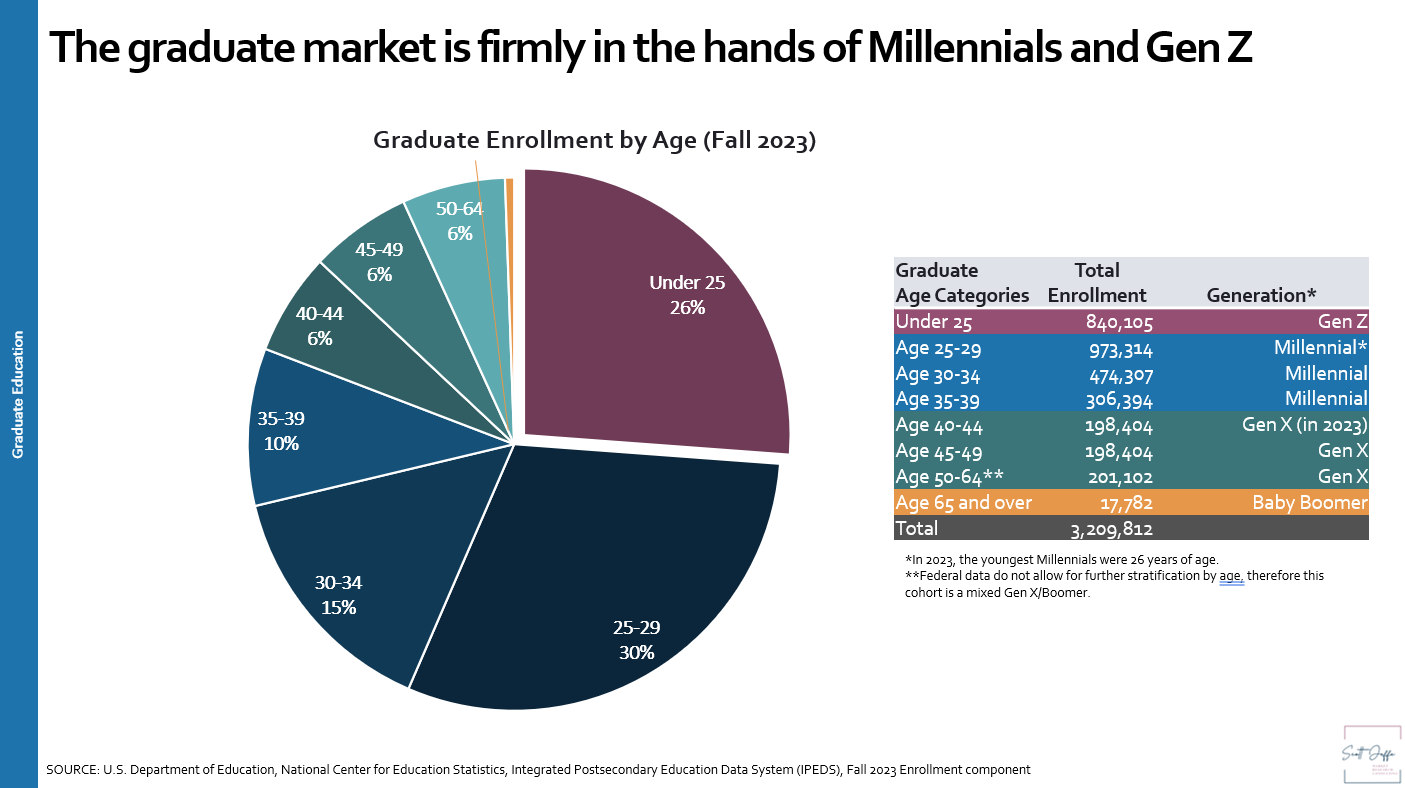
Conversations: Marketing to Gen Z and Millennials in Higher Education
“Gen Z can spot a stock photo from a mile away—be real, or risk being ignored.”
In this edition of Coffee with Scott, I sat down with Erin Minsart, a seasoned digital marketing leader who has worked with dozens of colleges and universities to shape their outreach strategies. Erin and I first crossed paths at RNL, where she led innovative digital campaigns that connected deeply with prospective students.
Our conversation focused on the evolving student market—particularly the rise of Gen Z as the (soon to be) dominant graduate audience—and how institutions can effectively market to multiple generations at once. From influencer culture to authentic messaging, Erin shares her insights on what resonates with Gen Z, how their expectations differ from Millennials, and how to craft campaigns that speak to both groups without losing focus.

IPEDs data showing the breakout of the U.S. graduate student population by (approximate) generation.
Scott: Within 24 months, Gen Z will become the primary target demographic for graduate programs, what are the most important things for marketers to understand in building messaging that resonates with them?
Erin: Gen Z is the influencer generation. They want to see people they know and respect using a product or service before they commit. They’re digital natives who have spent their entire lives filtering information, so they’re highly selective about what gets their attention. I recommend the Pain–Claim–Gain framework:
Pain: What problem are they facing?
Claim: How does your institution solve it?
Gain: What’s the tangible benefit for them?
For Gen Z, four pillars matter most in how they operate in the world – and will translate to their graduate education decisions:
Practical Outcomes & Career Advancement. Show specific job titles, salary gains, and career paths. Use alumni stories and employment stats to prove value.
Social Impact. Demonstrate how your programs contribute to positive change and align with their values.
Support & Accessibility. Highlight mental health, academic, and career services. Ensure your website is accessible and easy to navigate.
Transparency & Authenticity. Avoid sales pitches. Use real student testimonials and imagery—skip stock photos.
Scott: How does this differ from marketing to Millennials?
Erin: Millennials see themselves as lifelong learners and want to make the world a better place. Gen Z shares that goal, but they also focus more on personal growth, health, and leveraging technology to improve themselves. In marketing, this means:
Avoid overly polished content—embrace imperfections.
Lean into influencer partnerships and co-created content.
Speak in a conversational tone and keep it relatable.
In short, think of it this way:
Short-form video > long-form copy
Real voices > brand scripts
Quick stats > lengthy reports
Scott: Graduate programs will continue to serve both Gen Z and Millennials for some time. How do you balance marketing to ensure that it resonates with both?
Erin: Personalization is the core trait they share. While some brand messages can span generations, each group needs to feel seen and understood.
Gen Z demands even more personalization and – somewhat unlike Millennials – they are highly price-conscious. They’re more aware of (and open to) alternative credentials from both trade schools and non-higher education providers, so higher ed needs to balance qualitative and quantitative benefits and give a lot more focus to both career prospects and ROI, answering questions like:
How much will I make?
What financial aid is available?
Do I share this institution’s values?
Use persona-based marketing to map the decision journey for each generation. Build campaigns that answer the right questions at the right time—guiding prospects naturally from consideration → decision → enrollment.
Scott: What are the most important takeaways for graduate marketers today?
Erin: Here are five takeaways:
Gen Z is pragmatic and results-driven. Clear, career-focused messaging is essential.
Authenticity beats polish. Real stories and unfiltered content resonate more than perfection.
Support and inclusivity are must-haves. Show your commitment to student well-being and accessibility.
Millennials and Gen Z share values, but motivations differ. Millennials focus on global change; Gen Z prioritizes personal betterment.
Tailor, don’t blend. Personalized messaging for each group ensures relevance without diluting impact.
My Take. Gen Z’s expectations are shaping the future in very unique ways. The way they see (and operate in) the world is increasingly being adopted by their preceding generations, whether it be their outcomes focus, their ROI mentality, or their overall increased skepticism. As Erin notes, higher education marketers who embrace authenticity, focus on clear outcomes, and personalize their approach will not only connect with Gen Z but also strengthen their appeal to Millennials and beyond.